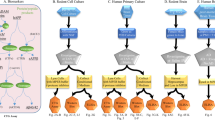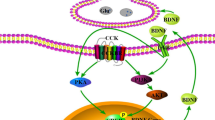Abstract
The senile plaque in Alzheimer’s disease (AD) consists mainly of the amyloid β-peptide (Aβ) derived from a family of large integral membrane glycoproteins, beta-amyloid precursor proteins (βAPP). Soluble derivatives of βAPP generated by the proteolytic processing of full-length βAPP are normally secreted into the conditioned medium of cultured cells. Here we have investigated the possibility that the processing of βAPP can be regulated by the cholinesterase inhibitors physostigmine and tacrine. Both drugs mildly improve cognitive functions in some patients with AD. We analyzed the level of βAPP in glial, neuroblastoma, and pheochromocytoma cells by immunoblotting cell lysates and conditioned media using a monoclonal antibody, MAb22C11. The levels of soluble βAPP derivatives normally present in conditioned media were severely inhibited by treating cells with tacrine but not with physostigmine. Whereas the treatment of cells with tacrine resulted in a small decrease in the intracellular levels of βAPP, treating cells with physostigmine resulted in a slight increase in the intracellular levels of βAPP compared to untreated cells. The effect of tacrine on the secretion of βAPP was not affected by cotreating cells with muscarinic agents, staurosporine, or the calcium ionophore. Our results suggest that a decrease in the secretion of βAPP by tacrine did not depend on its anticholinesterase activity and that tacrine operates via a noncholinergic mechanism.
Similar content being viewed by others
References
Becker R. and Giacobini E. (1994)Cholinergic Basis of Alzheimer’s Disease. Birkhauser, Boston, MA.
Bradford M. M. (1976) A rapid and sensitive method for the quantitation of microgram quantities of protein utilizing the principle of protein-dye binding.Anal. Biochem. 72, 248–254.
Buxbaum J. D., Oishi M., Chen H. I., Pinkas-Kramarski R., Jaffe E. A., Gandy S. E., and Greengard P. (1992) Cholinergic agonists and interleukin 1 regulate processing and secretion of the Alzheimer beta/A4 amyloid protein precursor.Proc. Natl. Acad. Sci. USA 89, 10,075–10,078.
Checler F. (1995) Processing of the β-amyloid precursor protein and its regulation in Alzheimer’s disease.J. Neurochem. 65, 1431–1444.
Dell’Antone P., Bragadin M., and Zatta P. (1995) Anticholinesterase drugs: tacrine but not physostigmine, accumulates in acidic compartments of the cells.Biochim. Biophys. Acta 1270, 137–141.
Esch F. S., Keim P. S., Beattie E. C., Blacher R. W., Culwell A. R., Oltersdorf T., McClure D., and Ward P. J. (1990) Cleavage of amyloid β-peptide during constitutive processing of its precursor.Science 248, 1122–1124.
Estus S., Golde T. E., Kunishita T., Blades D., Lowery D., Eisen M., Usiak M., Qu X., Tabira T., Greenberg B. D., and Younkin S. G. (1992) Potentially amyloidogenic, carboxyl-terminal derivatives of the amyloid protein precursor.Science 255, 726–728.
Farlow M., Gracon S. I., Hershey L. A., Lewis K. W., Sadowsky C. H., and Dolan-Ureno J. (1992) A controlled trial of tacrine in Alzheimer’s disease.JAMA 268, 2523–2529.
Furukawa K., Barger S. W., Blalock E. M., and Mattson M. P. (1996) Activation of K+ channels and suppression of neuronal activity by secreted β-amyloid-precursor protein.Nature 379, 74–78.
Greig N. H., Pei X.-F., Soncrant T. T., Ingram D. K., and Brossi A. (1995) Phenserine and ring Cheteroanalogues: drug candidates for the treatment of Alzheimer’s disease.Med. Res. Rev. 15, 3–31.
Growdon J. H. (1992) Treatment for Alzheimer’s disease?New Eng. J. Med. 327, 1306–1308.
Haass C., Koo E. H., Mellon A., Hung A. Y., and Selkoe D. J. (1992) Targeting of cell-surface beta-amyloid precursor protein to lysosomes: alternative processing into amyloid-bearing fragments.Nature 357, 500–503.
Hay R., Caputo J., Chen T. R., Macy M., McClintock P., and Reid Y. (1992)ATCC Collection Catalogue of Cell Lines and Hybridomas, 7th ed., ATCC, Rockville, MD.
Hilbich C., Monning U., Grund C., Masters C. L., and Beyreuther K. (1993) Amyloid-like properties of peptides flanking the epitope of amyloid precursor protein-specific monoclonal antibody 22C11.J. Biol. Chem. 268, 26,571–26,577.
John V., Lieberburg I., and Thorsett E. D. (1993) Alzheimer’s disease: current therapeutic approaches.Ann. Rep. Med. Chem. 28, 197–206.
Kang J., Lemaire H. G., Unterbeck A., Salbaum J. M., Masters C. L., Grezeschik K. H., Multhaup G., Beyreuther K., and Muller-Hil B. (1987) The precursor of Alzheimer’s disease amyloid A4 protein resembles a cell-surface receptor.Nature 325, 733–736.
Katzung G. B. (1995) Basic principles: introduction, inBasic and Clinical Pharmacology (Katzung G. B., ed.), Appleton & Lange, Norwalk, CT, pp. 1–8.
Kim K. S., Miller D. L., Sapienze B. J., Chang C. J., Grundke-Iqbal I., Currie J. R., and Wisniewski H. M. (1988) Production and characterization of monoclonal antibodies to synthetic cerebral vascular amyloid peptide.Neurosci. Res. Commun. 2, 121–130.
Knops J., Lieberburg I., and Sinha S. (1992) Evidence for a nonsecretory, acidic degradation pathway for amyloid precursor protein in 293 cells.J. Biol. Chem. 267, 16,022–16,024.
Kuentzel S. L., Ali S. M., Altman R. A., Greenberg B. D., and Raub T. J. (1993) The Alzheimer β-amyloid protein precursor/protease nexin-II is cleaved by secretase in a trans-Golgi secretory compartment in human neuroglioma cells.Biochem. J. 295, 367–378.
Lahiri D. K. (1994a) Effect of ionophores on the processing of the beta-amyloid precursor protein in different cell lines.Cell. Mol. Neurobiol. 14, 297–313.
Lahiri D. K. (1994b) Reversibility of the effect of tacrine on the secretion of the beta-amyloid precursor protein in cultured cells.Neurosci. Lett. 181, 149–152.
Lahiri D. K., Lewis S., and Farlow M. R. (1994) Tacrine alters the processing of beta-amyloid precursor protein in different cell lines.J. Neurosci. Res. 37, 777–787.
Lahiri D. K., Nall C., and Farlow M. R. (1992) The cholinergic agonist carbachol reduces intracellular amyloid precursor protein in PC12 and C6 cells.Biochem. Int. 28, 853–860.
Lamy P. P. (1994) The role of cholinesterase-inhibitors in Alzheimer’s disease.CNS Drugs 2, 146–165.
Merck & Co., Inc. (1989)The Merck Index (Budavari S., ed.), Merck & Co., Inc., Rahway, NJ.
Mohs R. C., Davis B. M., Johns C. A., Mathe A. A., Greenwald B. S., Horvath T. B., and Davis K. L. (1985) Oral physostigmine treatment of patients with Alzheimer’s disease.Am. J. Psych. 142, 28–33.
Nitsch R. M., Slack B. E., Wurtman R. J., and Growdon J. H. (1992) Release of Alzheimer amyloid precursor derivatives stimulated by activation of muscarinic acetylcholine receptors.Science 258, 304–307.
Parsell D. A. and Lindquist S. (1993) The function of heat-shock proteins in stress tolerance: degradation and reactivation of damaged proteins.Ann. Rev. Genet. 27, 437–496.
Refolo L., Salton S. R., Anderson J. P., Mehta P., and Robakis N. K. (1989) Nerve and epidermal growth factors induce the release of the Alzheimer amyloid precursor from PC12 cell cultures.Biochem. Biophys. Res. Commun. 164, 664–670.
Sambamurti K., Shioi J., Anderson J. P., Pappolla M. A., and Robakis N. K. (1992) Evidence for intracellular cleavage of the Alzheimer’s amyloid precursor in PC 12 cells.J. Neurosci. Res. 33, 319–329.
Selkoe D. J. (1994) Normal and abnormal biology of the β-amyloid precursor protein.Ann. Rev. Neurosci. 17, 489–517.
Sisodia S. S., Koo E. H., Beyreuther K., Unterbeck A., and Price D. L. (1990) Evidence that β-amyloid protein in Alzheimer’s disease is not derived by normal processing.Science 248, 492–495.
Sisodia S. S. and Price D. L. (1995) Role of the β-amyloid protein in Alzheimer’s disease.FASEB J. 9, 366–370.
Slunt H. H., Thinakaran G., Koch C. V., Lo A. C. Y., Tanzi R. E., and Sisodia S. S. (1993) Expression of a ubiquitous, cross-reactive homologue of the mouse β-amyloid precursor protein (APP).J. Biol. Chem. 269, 2637–2644.
Author information
Authors and Affiliations
Rights and permissions
About this article
Cite this article
Lahiri, D.K., Farlow, M.R. Differential effect of tacrine and physostigmine on the secretion of the β-amyloid precursor protein in cell lines. J Mol Neurosci 7, 41–49 (1996). https://doi.org/10.1007/BF02736847
Received:
Accepted:
Issue Date:
DOI: https://doi.org/10.1007/BF02736847




